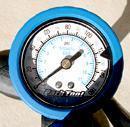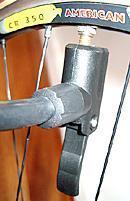
Recently on Cyclingnews.com |
Reviews
Pumpin' with Park
Park Tool PFP-3 Home Mechanic Floor Pump

|
For the Tim the Toolman in all of us, a good track pump becomes a necessity; Park Tool's PFP-3 Home Mechanic Floor Pump provided a perfect opportunity for Anthony Tan to flex his forearms as he put the pump though its paces.
For those unfamiliar with floor pumps, to describe them as a godsend is an understatement. I still remember umming and arring about buying the Silca Pista track pump (which I shall be basing most of my comparisons on since it's the only other one I used) when I was a budget-conscious student almost ten years ago, living on a frugal diet of baked beans on toast... and the odd beer or two.

|
As I witnessed my tyre effortlessly inflate past 100 psi in less than 60 seconds, as if by magic, my inhibitions soon vanished. Though entirely unnecessary, I was so chuffed at the ease of airflow from pump to tyre that I used to pump my tyres up before virtually every ride; my trusty Silca even came with me during my brief racing stint in Europe, where I found out within minutes just how bad a bike racer I really was and just how good the Dutch and Belgians were. Before my return though, in an effort to minimise the amount of excess luggage I had to pay, I made the gut-wrenching decision to part with him (yes, it was a he), and have been pump-less ever since.
So when Park Tool's PFP-3 floor pump arrived - destination moi via a brief stopover at Cyclingnews - I felt like a father who had finally reunited with his long-lost son.
The Park Tool company have travelled some way since their first invention conceived out the back of a Michigan bike shop back in 1963. Named the PRS-1, the Park Repair Stand V1.0 appeared to have come straight off the set of a Doctor Who episode (which, curiously enough, happened to be the same year the sci-fi TV series was created). The minimalist yet stylish PFP-3 demonstrates these lads have thankfully moved on in leaps and bounds since their first Darlek-looking concoction 40 years ago.
Up close

|
A wide, three-point moulded plastic base holds the steel barrel for the compression (outer) tube firmly in place, locked into position by a screw; the plunger shaft, a good length at 70cm (27") and also made of cast steel, extends to the base of a chunky steel handle housed in moulded plastic; the air delivery hose, securely fastened at both ends, has a dual air chuck/hose head that accommodates both Presta (French) and Schrader valves; and last, a mid-mounted pressure gauge for ease of reading is a thoughtful feature for the long-sighted, capable of reading up to the pump's maximum pressure of 160 psi (equal to 11 barometric atmospheres or BAR for short).
The company claims the PFP-3 to be 100 percent rebuildable, however the only thing I can think of that may require replacing is the hardened rubber insert inside the hose head. A nice little design element is the top cap on the compression tube that features two recesses to hold the air hose when not in use, and a ball pump pin that allows you to inflate footballs or blow-up toys - depending on one's choice of extra-curricular activities...
Workin' out

|
Securing the hose head onto the end of your tube valve is a cinch: unscrew the nozzle at the end of your tube valve, tap it once with your finger to break the seal of air if your tyres are partially inflated, hook the valve into the correct hole (be it Presta or Schrader), then lock the head into place with the thumb-lock. Once that's done, it's simply a case of pumping away until you've reached the desired air pressure. While the number of strokes required to pump a tyre is dependent on your choice of rim and tyre, for the record, on an American Classic CR-350 road rim and Pariba Service Course tyres - a fairly typical set-up - it took me on average, 23 full strokes to go from 0-100 psi (roughly 7 BAR) and 28 strokes to go from 0-120 psi (a tad over 8 BAR). Impressive stuff.
To accelerate my evaluation process, I've been using latex tubes for the last two months, which means I lose about 15-20 psi (about 1-1.5 BAR) each day I don't ride, but more importantly, I'm forced to pump up my wheels every time I go for a ride. A mere five to six strokes to go from 100-120 psi is very quick indeed - a feat unmatched by my Silca Pista (though largely due to the height difference - 63cm versus 50cm - rather than the efficiency of the pumping mechanism, I suspect). The thumb-lock is also an excellent idea, making it virtually impossible for any air to escape while the hose head is secured onto the valve.
A minor gripe, however, is when pumping a tyre that is completely flat. As you push down hard from the 0-40 psi range, your elbows experience a jarring effect as the hardened plastic that houses the steel handle hits the top cap of the compression tube; after that, the tyre's pressure cushions the 'blow' of the pump stroke. A rubber washer between these two parts would easily solve this problem. Also, it's important to make sure both your tube valves are identical - if you use a combination of a threaded and non-threaded valve, the rubber insert inside the head of the air hose will wear far quicker. However, this is something that will happen on any pump.
The verdict
Now the question you've all been waiting for: would I buy one?
Hell yeah - the PFP-3 makes your job as a home mechanic a pleasure, at least in the tyre department, anyway. If you're obsessive as I was back in my university days - or just sick of being out of breath before you've even begun pedalling - then this is a must-have accessory. And now you charge those kids across the road to pump up their footballs for them, too!
Photos
Images by Cyclingnews/Park Tool Co.
- Pumpin' with Park - Park Tool's PFP-3 Home Mechanic Floor Pump.
- A large gauge is mid-mounted for ease of reading, measuring from 0-160 psi, or 0-11 BAR.
- Once the air hose head is secured onto the tube valve, it's simply a case of pushing the thumb-lock down, then start pumping away.
- Park Tool's humble beginnings c. 1963 - this is where their first invention, their PRS-1 repair stand was devised.
- Warning warning - Darleks approaching... Park's earlier repair stands wouldn't have looked out of place on the set of the British sci-fi TV series Doctor Who.
- Another shot of the PFP-3.
Recommended retail price: US$29.95 (but we've seen them as low as $23.95)
Pro: Well designed, very fast inflation, easy-to-read guage
Con: Initial jarring of elbows when inflating a dead-flat tyre, air
hose a little short (70cm/27") for the pro mechanic
More information: Park
Tool website
Cyclingnews Rating: ![]()
What do you think of the Park Tool PFP-3 Home Mechanic Floor Pump? Let us know

